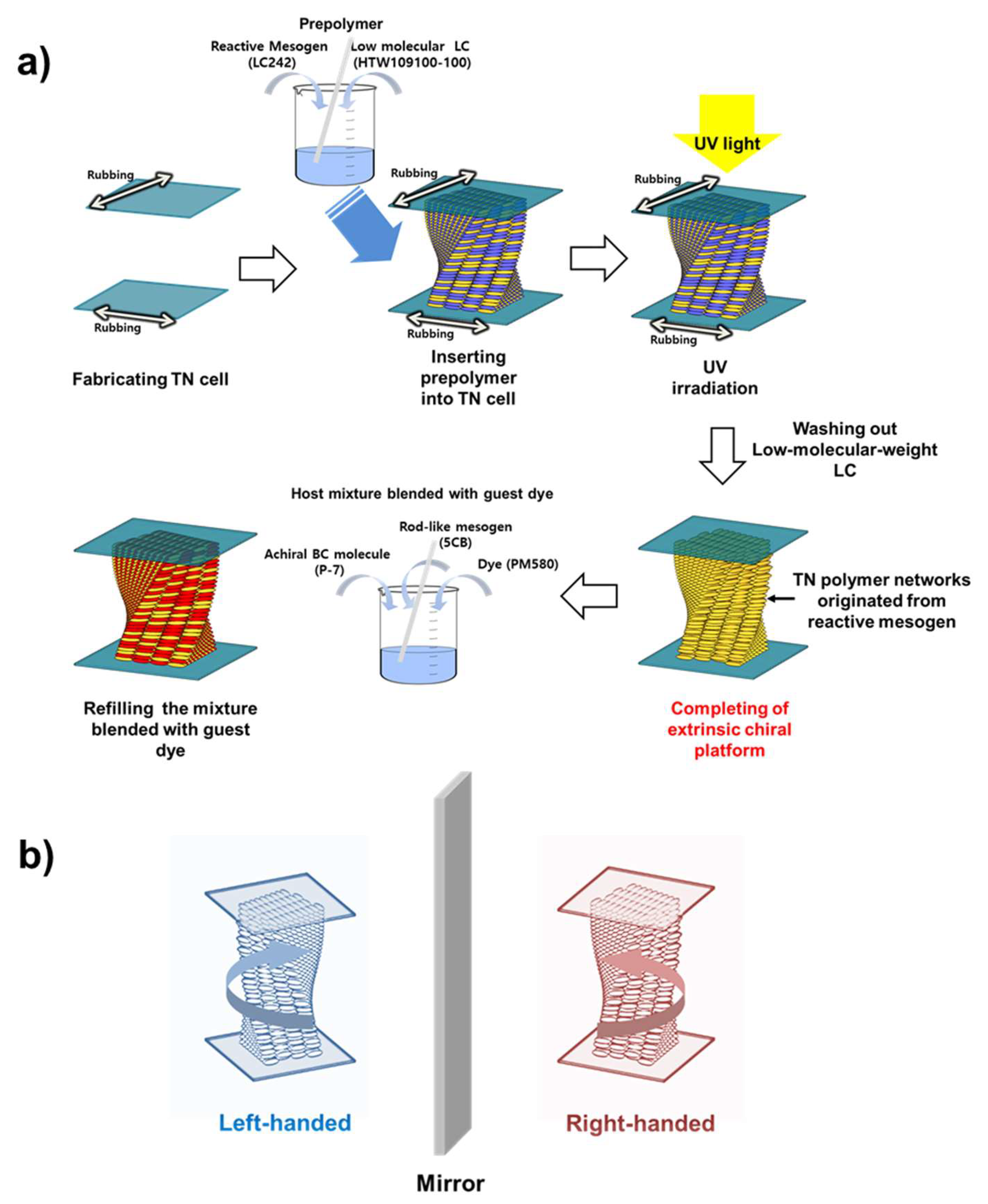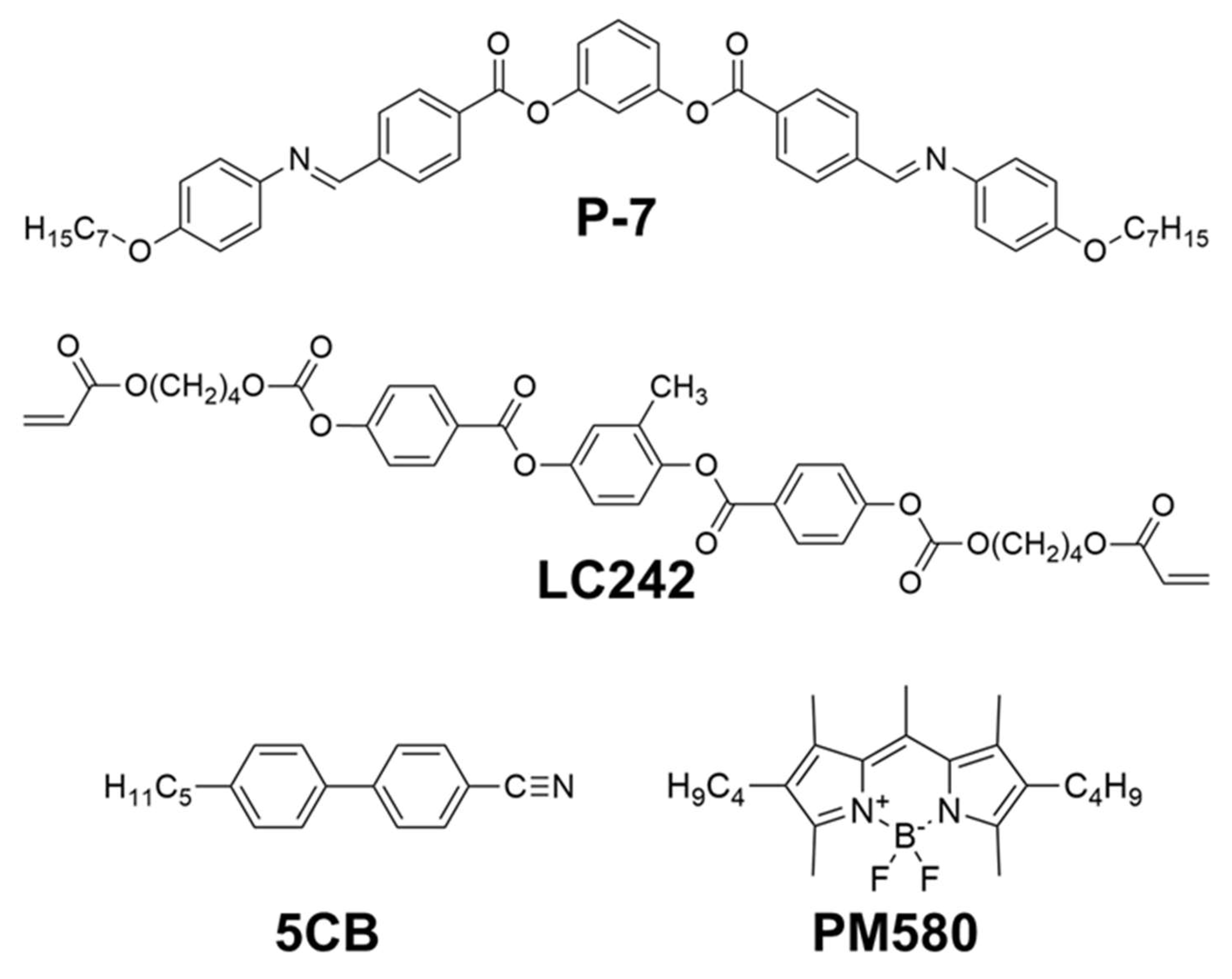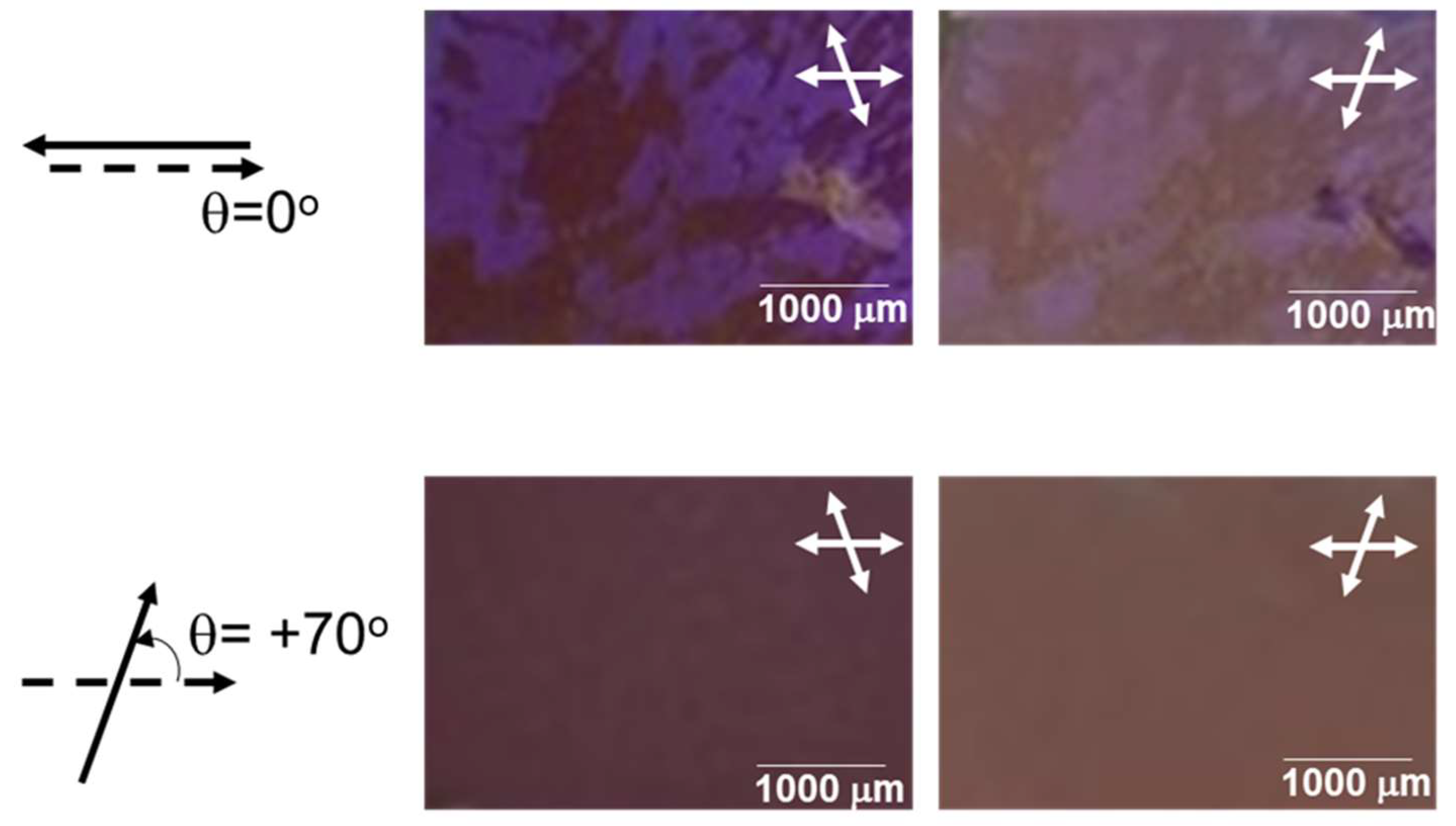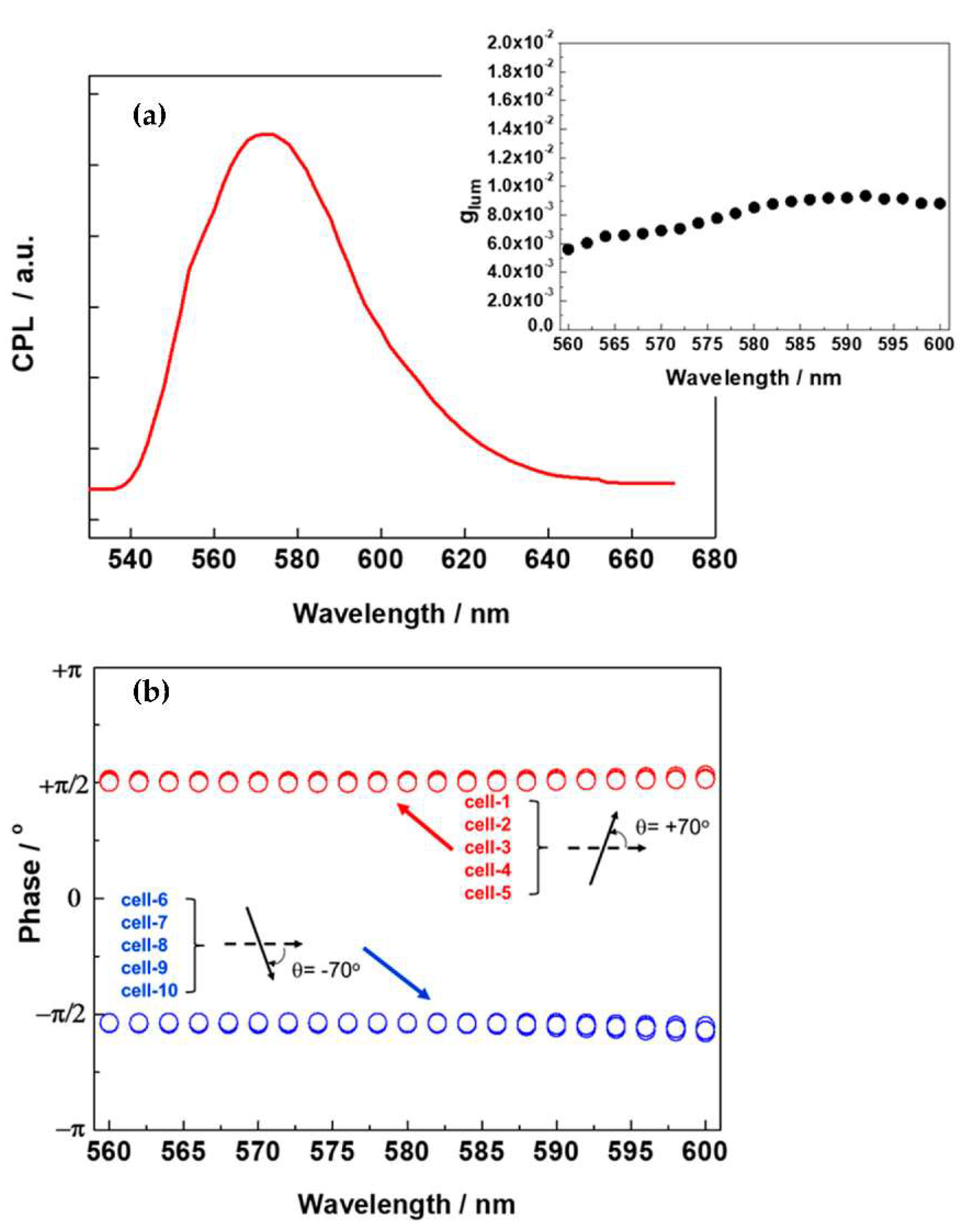Preferential Circularly Polarized Luminescence from a Nano-Segregated Liquid Crystalline Phase Using a Polymerized Twisted Nematic Platform
Abstract
1. Introduction
2. Experimental
2.1. Fabrication of the Extrinsic Chiral Platform
2.2. CPL Measurement
3. Results and Discussion
4. Conclusions
Author Contributions
Funding
Acknowledgments
Conflicts of Interest
References
- Takezoe, H.; Takanishi, Y. Bent-Core Liquid Crystals: Their Mysterious and Attractive World. Jpn. J. Appl. Phys. 2006, 45, 597–625. [Google Scholar] [CrossRef]
- Reddy, R.A.; Tschierske, C. Bent-Core Liquid Crystals: Polar Order, Superstructural Chirality and Spontaneous Desymmetrisation in Soft Matter Systems. J. Mater. Chem. 2006, 16, 907–961. [Google Scholar] [CrossRef]
- Le, K.V.; Takezoe, H.; Araoka, F. Chiral Superstructure Mesophases of Achiral Bent-Shaped Molecules—Hierarchical Chirality Amplification and Physical Properties. Adv. Mater. 2017, 29, 1602737. [Google Scholar] [CrossRef] [PubMed]
- Takanishi, Y.; Shin, G.J.; Jung, J.C.; Choi, S.W.; Ishikawa, K.; Watanabe, J.; Takezoe, H.; Toledano, P. Observation of Very Large Chiral Domains in a Liquid Crystal Phase Formed by Mixtures of Achiral Bent-Core and Rod Molecules. J. Mater. Chem. 2005, 15, 4020–4024. [Google Scholar] [CrossRef]
- Chen, D.; Tuchband, M.R.; Horanyi, B.; Korblova, E.; Walba, D.M.; Glaser, M.A.; Maclennan, J.E.; Clark, N.A. Diastereomeric Liquid Crystal Domains at the Mesoscale. Nat. Commun. 2015, 6, 7763. [Google Scholar] [CrossRef] [PubMed]
- Otani, T.; Araoka, F.; Ishikawa, K.; Takezoe, H. Enhanced Optical Activity by Achiral Rod-Like Molecules Nanosegregated in the B4 Structure of Achiral Bent-Core Molecules. J. Am. Chem. Soc. 2009, 131, 12368–12372. [Google Scholar] [CrossRef] [PubMed]
- Jeon, S.-W.; Kim, D.-Y.; Araoka, F.; Jeong, K.-W.; Choi, S.-W. Nanosegregated Chiral Materials with Self-Assembled Hierarchical Mesophases: Effect of Thermotropic and Photoinduced Polymorphism in Rodlike Molecules. Chem. Eur. J. 2017, 23, 17794–17799. [Google Scholar] [CrossRef] [PubMed]
- Kim, K.; Kim, H.; Jo, S.-Y.; Araoka, F.; Yoon, D.K.; Choi, S.-W. Photomodulated Supramolecular Chirality in Achiral Photoresponsive Rodlike Compounds Nanosegregated from the Helical Nanofilaments of Achiral Bent-Core Molecules. ACS Appl. Mater. Interfaces 2015, 7, 22686–22691. [Google Scholar] [CrossRef] [PubMed]
- Jeon, S.-W.; Choi, H.-J.; Bae, J.-H.; Kim, B.-C.; Choi, S.-W. Photomodulating Chiroptic Behaviors in Nanosegregated Mesophase from a Mixture System Consisting of Nonchiral Bent-Core and Photo-Responsive Rod-Like Mesogens. J. Inf. Disp. 2018, 19, 129–133. [Google Scholar] [CrossRef]
- Lee, J.-J.; Kim, B.-C.; Choi, H.-J.; Bae, S.; Araoka, F.; Choi, S.-W. Inverse Helical Nanofilament Networks Serving as a Chiral Nanotemplate. ACS Nano 2020, 14, 5243–5250. [Google Scholar] [CrossRef] [PubMed]
- Kim, B.-C.; Choi, H.-J.; Lee, J.-J.; Araoka, F.; Choi, S.-W. Circularly Polarized Luminescence Induced by Chiral Super Nanospaces. Adv. Funct. Mater. 2019, 29, 1903246. [Google Scholar] [CrossRef]
- Hough, L.E.; Jung, H.T.; Krüerke, D.; Heberling, M.S.; Nakata, M.; Jones, C.D.; Chen, D.; Link, D.R.; Zasadzinski, J.; Heppke, G.; et al. Helical Nanofilament Phases. Science 2009, 325, 456–460. [Google Scholar] [CrossRef] [PubMed]
- Choi, S.-W.; Kang, S.; Takanishi, Y.; Ishikawa, K.; Watanabe, J.; Takezoe, H. Intrinsic Chirality in a Bent-Core Mesogen Induced by Extrinsic Chiral Structures. Angew. Chem. Int. Ed. 2006, 45, 6503–6506. [Google Scholar] [CrossRef] [PubMed]
- Ueda, T.; Masuko, S.; Araoka, F.; Ishikawa, K.; Takezoe, H. A General Method for the Enantioselective Formation of Helical Nanofilaments. Angew. Chem. Int. Ed. 2013, 52, 6863–6866. [Google Scholar] [CrossRef] [PubMed]
- Riehl, J.P.; Richardson, F.S. Circularly Polarized Luminescence Spectroscopy. Chem. Rev. 1986, 86, 1–16. [Google Scholar] [CrossRef]
- Araoka, F.; Sugiyama, G.; Ishikawa, K.; Takezoe, H. Highly Ordered Helical Nanofilament Assembly Aligned by a Nematic Director Field. Adv. Funct. Mater. 2013, 23, 2701–2707. [Google Scholar] [CrossRef]
- Baek, K.; Lee, D.M.; Lee, Y.J.; Choi, H.; Seo, J.; Kang, I.; Yu, C.J.; Kim, J.H. Simultaneous emission of orthogonal handedness in circular polarization from a single luminophore. Light Sci. Appl. 2019, 8, 120. [Google Scholar] [CrossRef] [PubMed]
- Lee, J.-J.; Choi, S.-W. Enhancement of Luminescence Dissymmetry Factor in Nano-Segregated Phase Generated by Phase Separation between Helical Nanofilaments and Liquid-Crystalline Smectic A Phase. Crystals 2020, 10, 952. [Google Scholar] [CrossRef]




Publisher’s Note: MDPI stays neutral with regard to jurisdictional claims in published maps and institutional affiliations. |
© 2020 by the authors. Licensee MDPI, Basel, Switzerland. This article is an open access article distributed under the terms and conditions of the Creative Commons Attribution (CC BY) license (http://creativecommons.org/licenses/by/4.0/).
Share and Cite
Lee, J.-J.; Choi, S.-W. Preferential Circularly Polarized Luminescence from a Nano-Segregated Liquid Crystalline Phase Using a Polymerized Twisted Nematic Platform. Polymers 2020, 12, 2529. https://doi.org/10.3390/polym12112529
Lee J-J, Choi S-W. Preferential Circularly Polarized Luminescence from a Nano-Segregated Liquid Crystalline Phase Using a Polymerized Twisted Nematic Platform. Polymers. 2020; 12(11):2529. https://doi.org/10.3390/polym12112529
Chicago/Turabian StyleLee, Jae-Jin, and Suk-Won Choi. 2020. "Preferential Circularly Polarized Luminescence from a Nano-Segregated Liquid Crystalline Phase Using a Polymerized Twisted Nematic Platform" Polymers 12, no. 11: 2529. https://doi.org/10.3390/polym12112529
APA StyleLee, J.-J., & Choi, S.-W. (2020). Preferential Circularly Polarized Luminescence from a Nano-Segregated Liquid Crystalline Phase Using a Polymerized Twisted Nematic Platform. Polymers, 12(11), 2529. https://doi.org/10.3390/polym12112529





